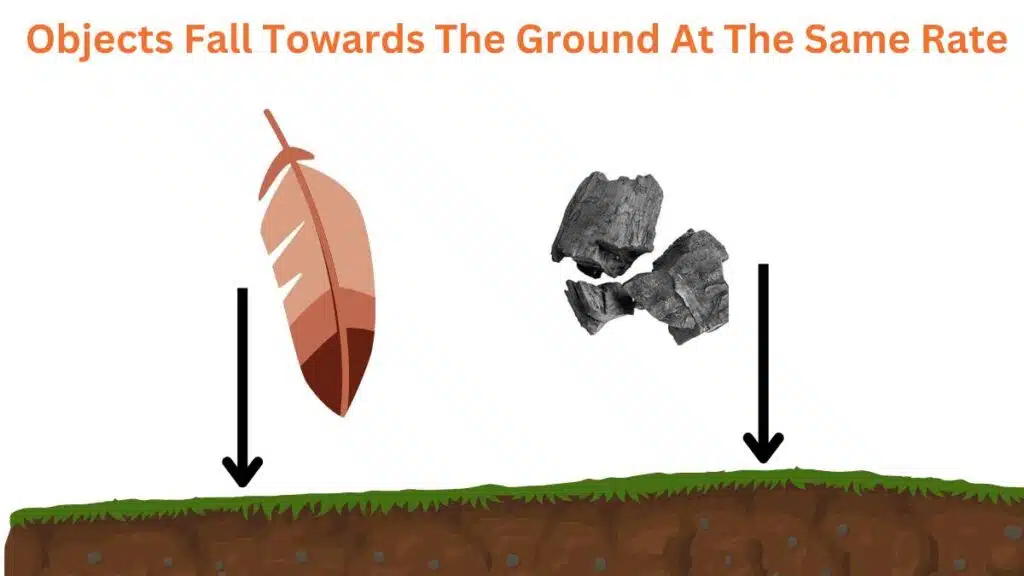Why Do All Objects Fall Towards The Ground At The Same Rate Regardless Of Their Weight?
It is a common misconception that a feather and a bowling ball will fall to the ground at different rates. However, this is not the case. In the absence of air resistance, all objects fall at the same rate regardless of their weight. This is because the force of gravity is the same for all objects, regardless of their mass. The only factor that affects the rate at which an object falls is air resistance.
Galileo’s Experiment on Falling Objects
The phenomenon of objects falling at the same rate regardless of their weight has been known for centuries. It was first demonstrated by Galileo Galilei in the 16th century. Galileo’s experiment involved dropping two objects of different masses from the Leaning Tower of Pisa. He found that the objects hit the ground at the same time.

The reason why objects fall at the same rate in a vacuum is that there is no air resistance to slow them down. In the presence of air resistance, however, objects with different masses will fall at different rates. This is because the air resistance will be greater for objects with a larger surface area. For example, a feather will fall more slowly than a bowling ball in the presence of air resistance.
What is Gravity?
Gravity is the force that pulls objects towards the center of the Earth. It is a fundamental force of nature and it plays a crucial role in many phenomena, including the falling of objects.
Einstein’s theory of general relativity
Einstein’s general theory of relativity revolutionized our understanding of gravity. It describes gravity as the curvature of spacetime caused by the presence of mass and energy. In this framework, objects with mass create a curvature in spacetime, and other objects move along these curved paths.
This theory successfully explains phenomena like the bending of light around massive objects and the existence of black holes.
Difference Between Mass And Weight
It is essential to differentiate between mass and weight to comprehend why objects fall at the same rate. Mass refers to the amount of matter in an object and remains constant regardless of the object’s location.
On the other hand, weight depends on the force of gravity acting on an object. Since gravitational acceleration is constant near the Earth’s surface, objects experience the same acceleration regardless of their mass, leading to identical falling rates.
Falling Objects and Air Resistance
In a vacuum, where there is no air resistance, all objects indeed fall at the same rate due to the uniform acceleration caused by gravity. However, in the real world, air resistance affects the descent of objects. Objects with a larger surface area experience more air resistance, altering their fall rate compared to objects with a smaller surface area.
The Influence of Altitude on Falling Objects
As altitude increases, the acceleration due to gravity slightly decreases. This decrease is due to the increasing distance between the object and the Earth’s center, according to Newton’s Law of Universal Gravitation. Consequently, the falling rate of objects differs slightly at different altitudes, though the effect is relatively small.
Falling Objects on Other Planets and Moons
The phenomenon of objects falling at the same rate, regardless of their weight, is not limited to Earth alone. It extends to other celestial bodies as well. The acceleration due to gravity varies from planet to planet and moon to moon, but objects still fall at the same rate relative to the acceleration of gravity on that celestial body.
Why Do All Objects Fall at the Same Rate?
The equivalence principle states that inertial mass and gravitational mass are the same. This means that objects of different masses experience the same gravitational force, and they will fall at the same rate in a gravitational field. The acceleration due to gravity is constant near the Earth’s surface, so objects of different masses will fall at the same rate on Earth.
The Role of Mass and Gravity
The gravitational force acting on an object is proportional to its mass. However, the acceleration experienced by the object due to gravity is inversely proportional to its mass. These two factors precisely balance out, leading to an identical fall rate for all objects, irrespective of their weight.



Leave a Reply